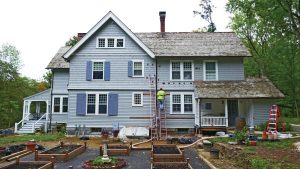Real Estate
Cracking the Affordability Code: Restoring Homes for Millions

Cracking the Affordability Code: Restoring Homes for Millions
Affordable housing has evolved into a pressing global issue, with millions of individuals and families struggling to secure safe and reasonably priced accommodations. As housing prices continue to rise and wages remain stagnant, it’s essential to explore innovative solutions to address this crisis. One such promising strategy involves the restoration of existing homes, which can play a significant role in unlocking the affordability code and providing solutions for millions in need.
The Growing Affordable Housing Crisis
The affordable housing crisis is not limited to a single region or demographic; it’s a worldwide challenge. Individuals from all walks of life, from urban to rural settings, find themselves grappling with the harsh reality of an unaffordable housing market. Whether it’s young professionals, low-income families, or retirees on fixed incomes, the struggle to secure a stable, affordable place to call home is a common thread. The urgency of this situation calls for out-of-the-box thinking and innovative approaches to ensure housing is accessible for everyone.
The Power of Restoration: Maximizing Existing Resources
One of the key solutions to this crisis lies in the restoration of existing homes. This approach involves revitalizing and renovating structures that may be abandoned or in disrepair. The power of home restoration lies in its ability to maximize existing resources. Instead of relying solely on new construction, which can be costly and time-consuming, restoration allows us to leverage the housing stock already in place.
Cost-Effective Transformation
The financial benefits of restoration are notable. Transforming an existing home is often less expensive than constructing a new one from the ground up. This makes it a viable solution for homeowners, investors, and organizations looking to create affordable housing options. The cost-effectiveness of restoration can reduce the financial burden on individuals and institutions seeking to address the affordable housing crisis.
Preserving Community Character
Restoring homes is not just about economics; it’s also about preserving the character and history of communities. Each neighborhood has a unique identity, and the restoration of existing homes helps maintain and enhance that identity. This approach fosters a sense of belonging and pride among residents, contributing to a strong community spirit. It also maintains the architectural identity of neighborhoods, which can be a powerful draw for those seeking to live in an area with character and history. In this way, restoration benefits not only current residents but also future generations.
Table 1: Benefits of Home Restoration
| Benefit | Key Advantages |
|---|---|
| Maximizing Resources | Lower investment compared to new construction. |
| Preserving Community | Maintains community character and history. |

Image by: https://www.oldhouseonline.com/
Government Initiatives: Support for Restoration
Governments at various levels are recognizing the importance of home restoration in addressing the affordable housing crisis. They are implementing policies and providing incentives to encourage the restoration of existing housing stock.
Tax Incentives
One significant way governments are incentivizing home restoration is through tax incentives. These incentives come in the form of deductions or tax credits for restoration projects. By providing financial benefits to homeowners and investors engaged in restoration efforts, governments aim to make this approach more attractive.
Regulatory Support
Another crucial aspect of government involvement is regulatory support. Streamlining regulations and permitting processes for restoration projects can significantly expedite the transformation of homes. Governments are actively working to reduce bureaucratic hurdles and make it easier for homeowners to navigate the restoration process.
Table 2: Government Initiatives for Home Restoration
| Initiative | Key Actions |
|---|---|
| Tax Incentives | Deductions and credits for restoration. |
| Regulatory Support | Streamlined permitting processes. |
Community Engagement: A Vital Component
Community engagement is a critical aspect of home restoration efforts. Local organizations, nonprofits, and volunteers often play a vital role in these projects.
Community-Based Projects
Community-based restoration projects have been gaining momentum, bringing people together to work on improving housing conditions. These initiatives not only restore homes but also build a sense of unity and pride within neighborhoods. They exemplify the power of communities to drive change and create affordable housing solutions from within.
Affordable Housing Nonprofits
Nonprofits dedicated to affordable housing have expanded their focus to include restoration efforts. They acquire homes in need of repair and undertake the necessary renovations to ensure that they remain accessible to those in need. This approach not only adds to the affordable housing stock but also creates a sustainable path to homeownership for many.
Table 3: Community Engagement in Home Restoration
| Community Involvement | Key Aspects |
|---|---|
| Community-Based Projects | Unites people in improving housing. |
| Affordable Housing Nonprofits | Acquire and restore homes for accessibility. |
The Path Forward: Collaboration and Innovation
Cracking the affordability code through home restoration is a multifaceted effort that requires collaboration between governments, communities, and homeowners. By maximizing existing resources, preserving community character, and leveraging government support and community engagement, we can make significant strides in addressing the affordable housing crisis. The path forward is one of collaboration, innovation, and a shared commitment to making housing affordable for all.
Conclusion
The restoration of homes for millions is not just a strategy for addressing the affordable housing crisis; it’s a call to action. The power of restoration lies in its ability to make the best use of existing resources while preserving the essence of our communities. With the support of governments, communities, and individuals, we can crack the affordability code and provide affordable housing solutions for millions in need. The journey toward accessible and affordable housing is a shared one, and it begins with the restoration of homes.
Real Estate
Revamp Your Real Estate Portfolio with Data-Driven Insights

Introduction
Revamping your real estate portfolio doesn’t have to rely on gut feelings alone. By tapping into data-driven insights and real estate market analytics, you can make informed choices about where to buy, hold, or sell. Imagine knowing which neighborhoods are about to boom, spotting under priced gems before everyone else, or avoiding a market about to cool. This article walks you through clear, simple steps to harness data for long-term, smarter real estate investing. You’ll see practical tips, real metrics to watch, interest rates, risk management investing strategy and easy tools anyone can use, even if you’re not a tech expert.
What Are Data-Driven Insights?

Image by: Yandex.com
Data-driven insights mean using numbers and trends instead of opinions. In real estate, you pull information on home prices, rent levels, population growth, and local job listings. You can get this from public records, real estate websites, or local housing authorities. Once you gather this data, you analyze it for patterns. For example, you might notice that a small city saw a 10 percent rise in average rents over the last year. That signals strong demand and a chance for higher rental income. These facts guide your next moves, whether buying a rental property or selling before a downturn.
Why Real Estate Analytics Matters

Image by: Yandex.com
Every market has its cycles. Prices and demand rise and fall in response to jobs, infrastructure, and local policy changes. Real estate market trends analytics help you track these cycles in real time. You can compare average sale prices across districts, see which zip codes have the lowest vacancy rates, or even spot early signs of gentrification. This level of detail gives you an edge when negotiating. Instead of bidding blind, you present offers backed by concrete market data. Lenders, real estate investors, and partners also trust your analysis more, making it easier to secure favorable financing or joint-venture deals.
Role of Data in Portfolio Management

Image by: Yandex.com
Data serves as a detailed roadmap for every step in your real estate journey. Before you make an offer, you review price history and rental trends to ensure you’re paying a fair price. Once you own the property, dashboards monitor occupancy rates, tenant reviews, and local economic indicators so you can adjust rent or marketing strategies. Heat maps highlight up-and-coming districts before prices jump, letting you invest early. Regularly reviewing these insights keeps your portfolio aligned with your financial goals, helping you know exactly when to buy new properties or sell underperforming ones.
Steps to Collect and Organize Your Data

Image by: Yandex.com
- Select reliable sources. Use government property records, reputable real estate listing sites, and local rental market conditions reports.
- Set a regular schedule. Check and record key metrics at least once a month.
- Centralize your data. Store information in a single spreadsheet or free cloud tool. Keep columns for date, metric, property, and neighborhood.
- Visualize trends. Create simple charts to see lines go up or down. A flat or falling rent yield line is a sign to dig in.
With this routine, data gathering becomes a habit rather than a chore. You build a clear picture of how each asset performs over time.
How to Apply Predictive Modeling

Image by: Yandex.com
Predictive modeling uses historical patterns to forecast the future. Many user-friendly tools now offer this without coding:
- Input factors like local job growth, school ratings, and transport links.
- Run the model to see which areas are likely to appreciate or rent increases.
- Review heat maps that color-code neighborhoods by expected gains.
Even basic predictive outputs can steer you toward the best buys and warn you about slowing markets. You don’t need a data science degree—just a tool that guides you through input and then shows clear visuals.
Tips for Portfolio Optimization

Image by: Yandex.com
Optimizing means balancing safety and growth across assets. Here’s how to do it with data:
- Diversify locations. Pair stable urban rentals with higher-yield suburban or small-town properties.
- Set clear targets. Decide on minimum rent yield (e.g., 5 percent) and maximum vacancy rate (e.g., 3 percent).
- Automate alerts. Use apps to notify you if a metric crosses your limit.
- Rebalance annually. Sell properties that fall short and reinvest in stronger markets.
By following these data-backed rules, you reduce emotional investment decision-making and keep your overall returns on track.
Avoiding Common Pitfalls

Image by: Yandex.com
Even with data, mistakes happen if you rely on a single metric or ignore local nuance:
- Don’t chase one hot stat. A rapid price jump may reflect a one-time event, like a new factory.
- Check multiple sources. Confirm vacancy rates with local property managers, not just online listings.
- Stay aware of local news. Zoning changes, new highways, or school closings can flip a market fast.
- Avoid data paralysis. Collecting too many metrics can overwhelm you. Stick to five core numbers that matter most.
Future Trends in Real Estate Data

Image by: Yandex.com
The future promises even smarter, more accessible data tools for investors of all sizes. Artificial intelligence could soon forecast neighborhood growth before property values rise. Mobile apps may send instant alerts when rental demand shifts or a deal hits the market. Virtual and augmented reality might overlay market statistics on a live walk-through, giving you key facts while you stand inside a property. As these innovations roll out, data-driven strategies will become faster, easier, and more precise, opening up new opportunities for investors to make well-informed choices.
The next wave of data-driven insights will come from new sources:
- Satellite imagery tracking construction and new developments.
- Mobile-device data showing foot traffic near retail locations.
- Online review analysis gauging neighborhood sentiment.
Machine learning will refine predictions, making them more accurate and timely. Early adopters of these advanced analytics will capture the best investment opportunities before others even see them.
Comparative Table: Key Metrics to Track
| Metric | What It Shows | Why It Matters |
|---|---|---|
| Average Rent Yield | Rent income ÷ property value | Measures income potential |
| Vacancy Rate | Empty units ÷ total units | Indicates demand and risk |
| Price Growth Rate | Change in sale prices over 12 months | Shows appreciation speed |
| Cash-on-Cash Return | Net cash flow ÷ cash invested | Reflects actual cash performance |
| Loan-to-Value Ratio | Mortgage amount ÷ property value | Assesses financing risk |
Conclusion
Data is the key to unlocking better real estate returns. By using real estate analytics, tracking five core metrics, and applying predictive modeling, you turn guesswork into a clear strategy. Simple steps—like monthly data reviews and automated alerts—keep you on track. Diversify wisely, set firm targets, and rebalance each year to keep risk in check. As data tools evolve, staying curious and learning new features will keep your portfolio ahead of the curve. Embrace the power of facts, not hunches, and watch your investments thrive.
Real Estate
Auction Automation for MS Real Estate Agents

Let’s be honest—selling real estate in Mississippi is not for the faint of heart. Between fast-moving buyers in DeSoto County, fluctuating interest rates, and clients who still expect you to pick up their call at 9 p.m., the hustle is real. And if you’re a real estate agent trying to juggle both traditional listings and auctions? It’s even more chaotic.
But here’s the thing—auction automation is quietly becoming the biggest productivity hack in the Mississippi real estate scene. Especially for agents who use online platforms not just to showcase properties, but to actually close deals faster, smarter, and with less burnout.
Auctions Aren’t Just for Foreclosures Anymore
Mississippi’s market is changing. Investors are back. Suburban growth is picking up. First-time homebuyers are hunting for deals. And auctions—once reserved for bank-owned or distressed properties—are now a legit selling strategy for mainstream listings too.
According to the National Auctioneers Association, more than 25% of residential properties in the U.S. will be auctioned online by 2026, with states like Mississippi seeing a rise in land, multifamily, and even lakefront home auctions.
But here’s where most agents hit a wall: managing an auction manually is exhausting. You’ve got bidder emails coming in from three counties, reminders to send, property details to update in five places, and that one client who insists on printing everything.
Enter Auction Automation
Imagine if your auction listings could:
- Auto-schedule showings and open house alerts
- Automatically notify qualified bidders
- Track bid activity in real-time
- Sync to your real estate listing websites and CRM
- Send closing documents without you lifting a finger
That’s not just tech for the big-city brokerages anymore. Platforms like BidHom are making these features accessible to real estate brokerage websites of all sizes—including the ones right here in Mississippi.
Why MS Agents Need Automation—Now
Let’s break it down from a boots-on-the-ground perspective.
-
Time is Not on Your Side
When you’re handling 15 listings, showing appointments in two counties, and constantly updating your MLS entries, auctions add another layer of complexity. Automation lets you pre-set rules—like when to notify bidders or when to trigger closing workflows—so you’re not babysitting the system.
Instead of spending 4–6 hours per listing on manual admin, agents using automated auction platforms cut that time down by 70%. That’s a full workday saved every week.
-
No More Missed Bids or Miscommunication
Ever had a buyer claim they didn’t know the auction had ended? Or worse, missed a serious bid because it came in after hours? With automation, bidders get real-time updates, notifications, and countdowns. No more “I didn’t see your email” excuses.
The system handles transparency. You focus on strategy.
-
Seamless Integration with Your Site
Your real estate listing website should be more than a digital business card. With the right automation tools, your auction listings feed directly into your site, complete with countdown timers, bid histories, and property details—all updated in real-time.
And if your real estate brokerage website runs on WordPress, Squarespace, or custom code? Platforms like BidHom are built to integrate without a tech team on retainer.
-
Better Seller Confidence, Faster Closings
Sellers in today’s market want speed and certainty. Auction automation shows them you’re not relying on chance—you’ve got a system in place. They can track bidder interest. They see the timelines. And they know that once the hammer drops, the next steps are already triggered.
Agents who use automated online auctions report 30–50% faster time-to-close, especially in cash-heavy markets like parts of Rankin County or Gulfport.
-
It’s Not Just for Big Brokerages
The biggest myth? “Automation is too complex for small agencies.” That’s outdated. BidHom was built with small teams in mind—offering built-in marketing tools, compliance checks, bidder verification, and seamless onboarding. No long learning curves.
Real Stories from the Field
“I used to run rural land auctions manually, updating three different spreadsheets,” says Lamar, a solo broker in north Mississippi. “Switched to an automated auction platform and suddenly, I’m closing faster and with fewer errors. I get to actually talk to my clients again.”
Or take Shauna, a Gulfport-based agent: “I integrated BidHom with my website and didn’t even need a developer. My listings look sharp, auctions run smoothly, and my sellers trust the process more.”
So, What’s Next?
If you’re a Mississippi agent tired of the paperwork, double-data entry, and auction chaos, it’s time to rethink your tech stack. Auction automation isn’t just some fancy extra—it’s the new baseline. And it’s leveling the playing field, especially for agents who want to scale without burning out.
Ready to Bring Automation to Your Auctions?
BidHom is a real estate listing websites builder and auction platform built for agents and brokers who want a simpler, faster way to manage listings—without tech headaches. From automated bidder updates to instant MLS syncing, BidHom puts you in control, not in chaos.
Book a free demo with BidHom and see how Mississippi agents are transforming their auction game.
Real Estate
Maximize Home Project Success with Residential Estimating Services

In residential construction and renovation, success often hinges on planning, accuracy, and cost control. Whether you’re a homeowner building from the ground up or a contractor bidding on remodels, having a clear understanding of project costs is crucial. This is where residential estimating services come into play. These specialized services provide comprehensive, itemized cost breakdowns that help streamline planning, avoid budget overruns, and ensure a smoother overall construction process.
Understanding the Role of Residential Estimating Services
Residential estimating services involve the systematic evaluation and projection of costs associated with residential construction projects. These services can cover everything from new builds and additions to kitchen renovations, roofing, and landscape upgrades. Unlike rough cost guesses or generic online calculators, professional estimating services take into account actual material prices, labor costs, local building codes, permit fees, and contingencies.
A well-prepared estimate becomes a vital reference document throughout the life of the project. It supports budget planning, contractor selection, and even loan applications. More importantly, it helps keep everyone accountable, from builders to subcontractors.
Why Accurate Estimates Matter More Than Ever
Construction costs have been fluctuating significantly in recent years due to inflation, material shortages, and supply chain issues. This unpredictability makes accurate cost estimation more critical than ever. Relying on outdated pricing models or guesswork can lead to major financial headaches, delays, and disputes between clients and contractors.
By investing in residential estimating services, you can avoid these issues. Professional estimators use the latest data and tools to provide realistic cost expectations based on your specific project scope and location. Whether you’re renovating a bathroom or constructing a multi-family property, these services bring essential financial clarity to the table.
The Process Behind Professional Estimating
The process of residential estimating services typically begins with a thorough review of your architectural plans, engineering drawings, or renovation concepts. Estimators then input this data into sophisticated estimating software that factors in thousands of variables. These include:
-
Square footage and layout complexity
-
Material choices (e.g., premium finishes vs. budget materials)
-
Local labor rates and union regulations
-
Building code requirements and permit costs
-
Equipment and subcontractor needs
-
Environmental or site-specific considerations
The result is a highly detailed estimate report, which outlines each cost element line by line. It’s not just about giving you a total number—it’s about breaking down how that number is reached so you can make better decisions and control spending.
Who Should Use Residential Estimating Services
While general contractors and developers are the most frequent users of residential estimating services, they are equally valuable for homeowners. Many individuals start construction or remodeling projects without a clear idea of how much things should cost. This can lead to sticker shock, change orders, or unfinished work due to lack of funds.
Homeowners using estimating services benefit from:
-
Realistic budget setting before starting the project
-
Enhanced ability to compare contractor bids
-
Increased confidence when securing financing
-
Reduced risk of unexpected expenses mid-project
Additionally, real estate investors and property managers who oversee multiple renovations or builds rely on professional estimates to ensure profitability and proper allocation of capital.
Key Benefits of Residential Estimating Services
Engaging professional estimating services adds a layer of security and expertise to any residential project. Some of the standout benefits include:
1. Cost Transparency:
Detailed reports mean there are no hidden charges or vague line items. You know exactly what you’re paying for.
2. Informed Decision Making:
With a full breakdown of expenses, clients can identify areas to cut costs or reallocate funds for better results.
3. Reduced Risk of Delays:
With accurate planning, contractors can schedule labor and material deliveries more efficiently, reducing downtime.
4. Better Communication:
When everyone—homeowner, contractor, architect—is working from the same cost estimate, collaboration is clearer and smoother.
5. Improved Contractor Selection:
Having a professional estimate in hand helps clients evaluate bids more objectively, preventing overpricing or underbidding issues.
Choosing the Right Estimating Partner
Not all residential estimating services are the same. Some firms specialize in high-end custom homes, while others focus on multi-family developments or green building projects. When choosing a provider, it’s important to assess their experience, accuracy, software tools, and familiarity with local building practices. Ask to see samples of past work, read reviews, and ensure they are licensed or certified if applicable in your region.
A good estimator will be transparent, communicative, and adaptable—willing to revise estimates as your project evolves or as material costs shift.
Conclusion
In the world of residential construction, success starts with knowledge—and that begins with accurate, professional cost estimation. Residential estimating services empower homeowners, builders, and investors to move forward with confidence, reduce financial risk, and keep their projects on track. With expert insights, up-to-date data, and meticulous planning, these services have become an essential part of the modern home-building process.
Whether you’re planning a small renovation or embarking on a large-scale build, don’t underestimate the value of getting your numbers right from the start. Invest in residential estimating services and build your future on a solid financial foundation.
-

 Business2 years ago
Business2 years agoCybersecurity Consulting Company SequelNet Provides Critical IT Support Services to Medical Billing Firm, Medical Optimum
-

 Business2 years ago
Business2 years agoTeam Communication Software Transforms Operations at Finance Innovate
-

 Business2 years ago
Business2 years agoProject Management Tool Transforms Long Island Business
-

 Business2 years ago
Business2 years agoHow Alleviate Poverty Utilized IPPBX’s All-in-One Solution to Transform Lives in New York City
-

 health2 years ago
health2 years agoBreast Cancer: The Imperative Role of Mammograms in Screening and Early Detection
-

 Sports2 years ago
Sports2 years agoUnstoppable Collaboration: D.C.’s Citi Open and Silicon Valley Classic Unite to Propel Women’s Tennis to New Heights
-

 Art /Entertainment2 years ago
Art /Entertainment2 years agoEmbracing Renewal: Sizdabedar Celebrations Unite Iranians in New York’s Eisenhower Park
-

 Finance2 years ago
Finance2 years agoThe Benefits of Starting a Side Hustle for Financial Freedom














